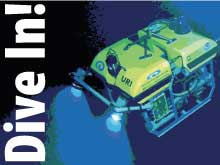
These lesson plans focus on the 2004 Estuary to the Abyss Expedition.
Education Lesson Plans
The National Oceanic and Atmospheric Administration (NOAA) has a great opportunity to reach out in new ways to teachers, students, and the general public through its ocean exploration efforts. One of our goals is to share the excitement of daily at-sea discoveries and the science behind its major ocean exploration initiatives with the people around the world. The 2004 Estuary to the Abyss Expedition: Exploring Along the Latitude 31-30 Transect presents a unique opportunity to engage explorers of all ages as we journey to a world that few have seen.
Using the Harbor Branch Oceanographic Institution’s research vessel Seward Johnson and its manned submersible, the Johnson-Sea-Link II, scientists will work along a latitude 31-30 transect line that extends from the coast to the deep sea. The expedition will concentrate on deeper waters (greater than 400 m) to complement previous studies of shallow-water faunas. This will extend our knowledge of bottom faunas from the estuary to the deep sea and enable us to understand the influence of distance from land, bottom type, and overlying water masses on the assemblages of organisms that dwell on the bottom.
A scientist from the Louisiana State University Wildlife Hospital will also be joining the expedition to determine whether deep-water fishes from a relatively pristine environment harbor bacteria that are resistant to antibiotics routinely used by medical and veterinary health professionals.
Educators and scientists working with NOAA during July 2004 developed a series of lesson plans for students in Grades 5-12 that are specifically tied to the Estuary to the Abyss Expedition. These lesson plans focus on cutting-edge ocean exploration and research using state-of-the-art technologies. Lessons focus on the exploration of deep-sea habitats, the physical and chemical processes associated with the Charleston Bump, and antimicrobial resistance in certain organisms based on distance from shore.
The lesson plans are grouped into the following categories:
Grades 5-6
Grades 7-8
Grades 9-12 (chemical, biological, earth, and
physical science)
Each grade-level grouping includes an activity that focuses on the exploration and research being conducted as part of the Estuary to the Abyss Expedition. In addition to being tied to the National Science Education Standards, the hands-on, inquiry-based activities include focus questions, background information for teachers, links to interesting Internet sites, and extensions. Web logs that document the latest discoveries and complement the lesson plans, complete with compelling images and video, will be sent back each day from sea. Teachers are encouraged to use the daily logs from the Estuary to the Abyss Expedition, which are posted on this site, to supplement the lesson plans.
Read a description of each lesson plan and/or download them to your computer. All of the lesson plans are available in pdf format, and may be viewed and printed with the free Adobe Acrobat Reader ![]() . To download a lesson plan, click on its title from the listing below.
. To download a lesson plan, click on its title from the listing below.
What’s
In That Cake? (6 pages, 188k)
Focus: Exploration of deep-sea habitats
In this activity, students
will be able to explain what a habitat is, describe
at least three functions or benefits that habitats
provide, and describe some habitats that are typical of the Charleston
Bump. Students will also be able to describe and discuss at least three
difficulties involved in studying deep-sea habitats and describe and
explain at least three techniques scientists use to sample habitats, such
as those found on the Charleston Bump.
Look
At That Bump! (10 pages, 220k)
Focus: Physical and chemical processes associated with the Charleston
Bump
In this activity, students will be able to describe
how the Charleston Bump affects the flow of water in
the Gulf Stream, describe the potential biological
significance of effects induced by the Charleston Bump, and use satellite
imagery to obtain information on chlorophyll concentration at selected
locations in the Earth’s oceans. Students
will also describe the chemical processes that produce
the rock-like surface of the Charleston Bump.
Superbugs (5
pages, 184k)
Focus: Antimicrobial
resistance
In this activity, students will
be able to define and explain antimicrobial resistance,
identify and explain at least three human activities that contribute to the
emergence of antimicrobial resistance, and explain
how research on deep-sea communities may contribute
to our knowledge and strategies for dealing with the
problem of antimicrobial resistance.
For More Information
Contact Paula Keener-Chavis, national education coordinator for the NOAA Office of Ocean Exploration, for more information.
Other lesson plans developed for this Web site are available in the Education Section.

























